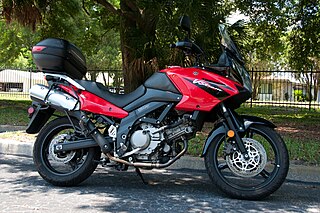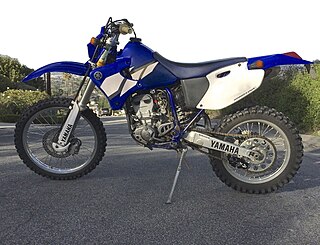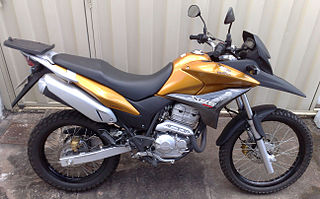
Mountain biking is a sport of riding bicycles off-road, often over rough terrain, usually using specially designed mountain bikes. Mountain bikes share similarities with other bikes but incorporate features designed to enhance durability and performance in rough terrain, such as air or coil-sprung shocks used as suspension, larger and wider wheels and tires, stronger frame materials, and mechanically or hydraulically actuated disc brakes. Mountain biking can generally be broken down into five distinct categories: cross country, trail riding, all mountain, downhill, and freeride.

Motocross is a form of off-road motorcycle racing held on enclosed off-road circuits. The sport evolved from motorcycle trials competitions held in the United Kingdom.

An all-terrain vehicle (ATV), also known as a light utility vehicle (LUV), a quad bike or quad, as defined by the American National Standards Institute (ANSI), is a vehicle that travels on low-pressure tires, has a seat that is straddled by the operator, and has handlebars. As the name implies, it is designed to handle a wider variety of terrain than most other vehicles. It is street-legal in some countries, but not in most states, territories and provinces of Australia, the United States, and Canada.

Supermoto is a form of motorcycle racing held on race tracks that alternate between three kinds of track surfaces: the hard packed dirt of flat track, the irregular jumps and obstacles of motocross, and the paved tarmac of road racing. Supermoto was originally conceived by Gavin Trippe in 1979 as a segment of the TV show Wide World of Sports. It was something like an all-star game, in which the best riders from the three separate genres of motorcycle racing could temporarily leave their normal race class to come together and compete for the title of best all around racer. Today supermoto is a distinct genre of its own and riders in the other classes do not routinely cross over into supermoto.
The Honda XR series is a range of four-stroke off-road motorcycles that were designed in Japan but assembled all over the world.

The six main types of motorcycles are generally recognized as standard, cruiser, touring, sports, off-road, and dual-purpose. Sport touring is sometimes recognized as a seventh category or integrated with the touring category.

The Suzuki V-Strom 650 (DL650) is a mid-weight, sport touring motorcycle made by Suzuki since 2004, in its third generation since model year 2017. It has a standard riding posture, fuel injection and an aluminum chassis. Marketed in Europe, Oceania, the Americas, and since 2018, India, the DL650 is manufactured at Suzuki's final assembly plant in Toyokawa, Japan. The V-Strom 650 trades strength in a single area for adaptability to a variety of riding conditions: commuting, cruising, adventure touring, and to a lesser degree, off-road riding. The bike is variously categorized as dual sport, sport enduro tourer, street/adventure, commuter, or entry-level.

The BMW GS series of one purpose off-road/on-road BMW motorcycles have been produced from 1980, when the R80G/S was launched, to the present day. The GS refers to either Gelände/Straße or Gelände Sport. GS motorcycles can be distinguished from other BMW models by their longer travel suspension, an upright riding position, and larger front wheels – typically 19 to 21 inch. In May 2009, the 500,000th GS was produced, an R1200GS model.

Montesa Honda is a subsidiary business of Honda, which assembles several models of motorcycles and bicycles in Barcelona, Spain. It was formed in 1944 by Pere Permanyer and Francesc Xavier "Paco" Bultó. The business was Spanish-owned until entering into an association with Honda.

A touring motorcycle is a type of motorcycle designed for touring. Although almost any motorcycle can be used for this purpose, manufacturers have developed specific models designed to address the particular needs of these riders. Touring motorcycles commonly have large displacement fairings and windshields that offer a high degree of weather and wind protection, large-capacity fuel tanks for long ranges between fill-ups, engines with a great deal of low-end horsepower, and a more relaxed, upright seating position than sport bikes.

The motorcycle sport of racing includes motorcycle road racing and off-road racing, both either on circuits or open courses, and track racing. Other categories include hill climbs, drag racing and land speed record trials.

An enduro motorcycle is an off-road racing motorcycle used in enduros, which are long-distance cross-country, Trails, time trial competitions.

Beta is an Italian motorcycle manufacturer, specialising in off-road motorcycles. Beta is best known for their popular observed trials bikes. In 2005, they launched a range of enduro motorcycles using KTM engines. In 2010 they launched the new RR series, with a new engine made in-house. Beta motorcycles have been used by world trials champions such as Jordi Tarrés, Dougie Lampkin, Albert Cabestany and Enduro riders Steve Holcombe and Brad Freeman. Production in 2018 was expected to be in excess of 20,000 motorcycles, ranging in size from 50 cc to 480 cc.

The Honda XR250R and XR250L are trail and dual-sport motorcycles made by Honda from 1979 through 2004, as part of the Honda XR series. They have four-stroke, SOHC four-valve 249 cc (15.2 cu in) single-cylinder engines.

A motorcycle tyre is the outer part of motorcycle wheel, attached to the rim, providing traction, resisting wear, absorbing surface irregularities, and allowing the motorcycle to turn via countersteering. The two tyres' contact patches are the motorcycle's connection to the ground, and so are fundamental to the motorcycle's suspension behaviour, and critically affect safety, braking, fuel economy, noise, and rider comfort.

Off-road tires are a category of vehicle tires that use deep tread to provide more traction on unpaved surfaces such as loose dirt, mud, sand, or gravel. Compared to ice or snow tires, they lack studs but contain deeper and wider grooves meant to help the tread sink into mud or gravel surfaces.

The Yamaha WR250F is an off-road motorcycle made by Yamaha Motor Company. It has a 250 cc (15 cu in) liquid-cooled single nikasil coated cylinder engine. First offered in 2001, it shared many components and design concepts with the YZ250F motocross model. It is basically the YZ250F detuned slightly for more controllable power, with a headlight and lighting coil, softer suspension, a kickstand, better noise specifications, larger radiators, and lower emissions. The WR250F is basically a YZ250F modified for enduro competitions, extreme enduro competitions and hard enduro competitions and the practice of these extreme sports. The WR in the name indicates a wide-ratio gear box common to most enduro or trail bikes and stands in contrast to the close-ratio gearbox essential to a motocross racer. Over the years the WR250F has benefited from the advances made in the YZ motocross version gaining advancements such as an aluminum frame and improved suspension.

The Honda XRE 300 is a single-cylinder dual-sport motorcycle designed and manufactured by Honda in Brazil. It was launched in August 2009 to simultaneously replace the Japanese firm's two South American on/off-road motorcycles: the XR250 Tornado and the NX-4 Falcon. Unlike these motorcycles' 250 cc and 400 cc engines, the fuel-injected 300 cc engine in the XRE300 meets Brazil's new PROMOT 3 emissions rules. It has an anti-lock brake (ABS) option.

The following outline is provided as an overview of motorcycles and motorcycling:

The KTM 950 Super Enduro R is a dual-sport motorcycle produced from 2006 to 2008. It is equipped with a 98-horsepower, four-stroke, V-twin engine, adjustable heavy-duty offroad suspension, and enduro styling. Due to its light weight and offroad-capable profile, the 950SE was perceived at its launch as a radical departure from any existing dual-sport, enduro, or street bike models, while having characteristics of all three.






















